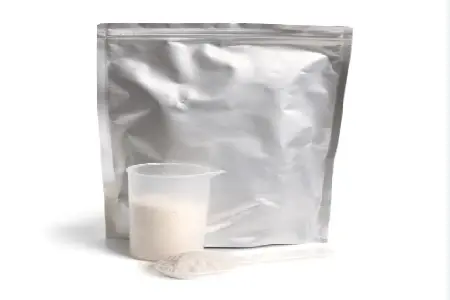Ibuprofen, a widely used nonsteroidal anti-inflammatory drug (NSAID), has become a staple in pain management and fever reduction. As a versatile active pharmaceutical ingredient (API), bulk ibuprofen powder serves as the foundation for numerous pharmaceutical formulations. This article delves into the diverse applications of ibuprofen powder in the pharmaceutical industry, exploring formulation techniques, excipient compatibility, and the distinctions between over-the-counter and prescription drug manufacturing.

Formulation Guide: Tablets, Capsules, and Topical Gels
The pharmaceutical applications of bulk ibuprofen powder are extensive, with various dosage forms catering to different patient needs and therapeutic goals. Let's examine the primary formulation types and their unique characteristics:
Tablet Formulations
Tablets remain the most common dosage form for ibuprofen due to their convenience and cost-effectiveness. The formulation process typically involves:
-
Direct compression: Suitable for immediate-release tablets, this method combines ibuprofen powder with excipients and compresses the mixture directly into tablets.
-
Wet granulation: This technique improves powder flow and compressibility, resulting in more uniform tablets with better dissolution properties.
-
Dry granulation: Useful for moisture-sensitive formulations, this method creates granules without using liquid binders.
Tablet coatings can be applied to mask the bitter taste of ibuprofen, protect against moisture, or modify drug release profiles. Enteric coatings, for instance, prevent gastric irritation by delaying drug release until the tablet reaches the small intestine.
Capsule Formulations
Capsules offer an alternative delivery method for bulk Ibuprofen Powder, with advantages such as:
-
Faster dissolution rates compared to some tablet formulations
-
Ability to encapsulate liquid or semi-solid formulations
-
Potential for combination products with other active ingredients
Both hard gelatin capsules and softgel capsules can be utilized, depending on the desired release profile and formulation characteristics.
Topical Gel Formulations
Ibuprofen gels provide localized pain relief with reduced systemic exposure. Key considerations in gel formulation include:
-
Selection of appropriate gelling agents (e.g., carbomers, cellulose derivatives)
-
Incorporation of penetration enhancers to improve drug absorption through the skin
-
Stability testing to ensure consistent drug release and shelf life
Topical ibuprofen formulations often include additional ingredients like menthol or camphor for their cooling and analgesic properties.

What Excipients are Compatible with Ibuprofen Powder?
The selection of appropriate excipients is crucial for developing stable, effective, and safe ibuprofen formulations. Compatibility between bulk ibuprofen powder and excipients impacts various aspects of the final product, including:
-
Physical and chemical stability
-
Dissolution rate and bioavailability
-
Manufacturing processability
-
Organoleptic properties
Let's explore some commonly used excipients and their compatibility with ibuprofen:
Diluents and Fillers
These excipients provide bulk and improve powder flow properties. Compatible options include:
-
Microcrystalline cellulose (MCC): Enhances compressibility and disintegration
-
Lactose monohydrate: Provides good flow properties and compressibility
-
Mannitol: Offers a pleasant mouth-feel and is suitable for moisture-sensitive formulations
Binders
Binders help hold the formulation together and improve tablet hardness. Compatible binders include:
-
Povidone (PVP): Effective in both wet and dry granulation processes
-
Hydroxypropyl methylcellulose (HPMC): Provides good binding properties and can also be used as a coating agent
-
Pregelatinized starch: Acts as both a binder and disintegrant
Disintegrants
These excipients facilitate tablet breakdown and drug release. Compatible disintegrants include:
-
Croscarmellose sodium: Rapid swelling properties for fast disintegration
-
Sodium starch glycolate: Effective in low concentrations
-
Crospovidone: Provides rapid disintegration without forming a gel
Lubricants and Glidants
These excipients improve powder flow and prevent sticking during tableting. Compatible options include:
-
Magnesium stearate: Widely used lubricant, but should be used in minimal quantities to avoid affecting dissolution
-
Colloidal silicon dioxide: Improves flow properties and acts as a glidant
-
Stearic acid: Alternative lubricant with good compatibility
pH Modifiers and Stabilizers
These excipients help maintain the stability of ibuprofen in various formulations:
-
Sodium bicarbonate: Acts as a pH modifier and can enhance dissolution in effervescent formulations
-
Citric acid: Used in combination with sodium bicarbonate for effervescent tablets
-
Antioxidants (e.g., butylated hydroxyanisole, butylated hydroxytoluene): Protect against oxidative degradation
It's important to note that while these excipients are generally compatible with ibuprofen, formulation scientists must conduct thorough compatibility studies to ensure optimal performance and stability in specific formulations.
Over-the-Counter (OTC) vs. Prescription Drug Manufacturing
The manufacturing processes for over-the-counter (OTC) and prescription ibuprofen products share many similarities, but there are key differences in regulatory requirements, dosage strengths, and marketing approaches. Understanding these distinctions is crucial for pharmaceutical companies working with bulk ibuprofen powder.
Regulatory Considerations
OTC ibuprofen products:
-
Must comply with monographs established by regulatory agencies (e.g., FDA OTC Monograph for Internal Analgesic, Antipyretic, and Antirheumatic Drug Products)
-
Generally have a streamlined approval process if they adhere to established monographs
-
Are subject to specific labeling requirements, including clear dosing instructions and warnings
Prescription ibuprofen products:
-
Require more extensive clinical trials and documentation for approval
-
May involve unique formulations or combinations not covered by OTC monographs
-
Have more flexibility in dosage strengths and formulation types
Dosage Strengths and Formulations
OTC ibuprofen products typically have lower dosage strengths, such as:
-
200 mg tablets or capsules for adults
-
100 mg/5 mL liquid formulations for children
-
Lower-strength topical gels (e.g., 5% w/w)
Prescription ibuprofen products may include:
-
Higher-strength tablets (e.g., 400 mg, 600 mg, 800 mg)
-
Extended-release formulations
-
Combination products with other active ingredients
-
Higher-strength topical formulations
Manufacturing Considerations
While the basic manufacturing processes are similar for OTC and prescription products, there may be differences in:
-
Scale of production: OTC products often require larger batch sizes to meet market demand
-
Quality control measures: Prescription products may have more stringent in-process controls and finished product testing
-
Packaging requirements: OTC products must be in child-resistant packaging and may have additional tamper-evident features
Marketing and Distribution
OTC ibuprofen products:
-
Can be marketed directly to consumers
-
Are available for purchase without a prescription
-
Often have brand-specific marketing campaigns and packaging designs
Prescription ibuprofen products:
-
Are marketed primarily to healthcare professionals
-
Require a prescription for dispensing
-
May be subject to more controlled distribution channels
Pharmacovigilance and Post-Market Surveillance
Both OTC and prescription ibuprofen products require ongoing safety monitoring, but the approaches may differ:
-
OTC products rely more heavily on consumer reporting of adverse events
-
Prescription products may have more structured post-market studies and physician reporting systems
Understanding these differences is essential for pharmaceutical companies to navigate the regulatory landscape and optimize their manufacturing and marketing strategies for both OTC and prescription ibuprofen products.
Conclusion
The pharmaceutical applications of bulk ibuprofen powder are diverse and continually evolving. From traditional tablet formulations to innovative topical gels, ibuprofen remains a versatile and essential API in the pharmaceutical industry. By understanding the nuances of formulation, excipient compatibility, and regulatory requirements, manufacturers can develop high-quality, effective ibuprofen products for both OTC and prescription markets.
As the demand for pain relief solutions continues to grow, the importance of reliable bulk ibuprofen powder suppliers cannot be overstated. Guangzhou Jianbei Biotechnology Co., Ltd. stands ready to meet this demand with our high-quality APIs and deep understanding of the pharmaceutical industry. Whether you're developing new formulations or seeking to optimize existing products, our team is committed to being your trusted partner in ibuprofen manufacturing.
Ready to elevate your ibuprofen formulations? Contact our expert team at h33727868@gmail.com to discuss your specific needs and discover how our premium bulk ibuprofen powder can enhance your pharmaceutical products.
References
1. Johnson, A. K., & Smith, R. L. (2020). Advances in Ibuprofen Formulation: From Tablets to Topicals. Journal of Pharmaceutical Sciences, 109(5), 1624-1635.
2. Zhang, Y., & Chen, X. (2019). Excipient Compatibility Studies in Ibuprofen Formulations: A Comprehensive Review. AAPS PharmSciTech, 20(7), 286.
3. Brown, M. E., & Taylor, P. W. (2021). Regulatory Considerations for OTC and Prescription Ibuprofen Products: A Global Perspective. Regulatory Toxicology and Pharmacology, 119, 104837.
4. Lee, S. H., & Park, J. Y. (2018). Novel Approaches to Enhancing Bioavailability of Ibuprofen: From Nanoformulations to Combination Therapies. Drug Delivery and Translational Research, 8(5), 1571-1583.










